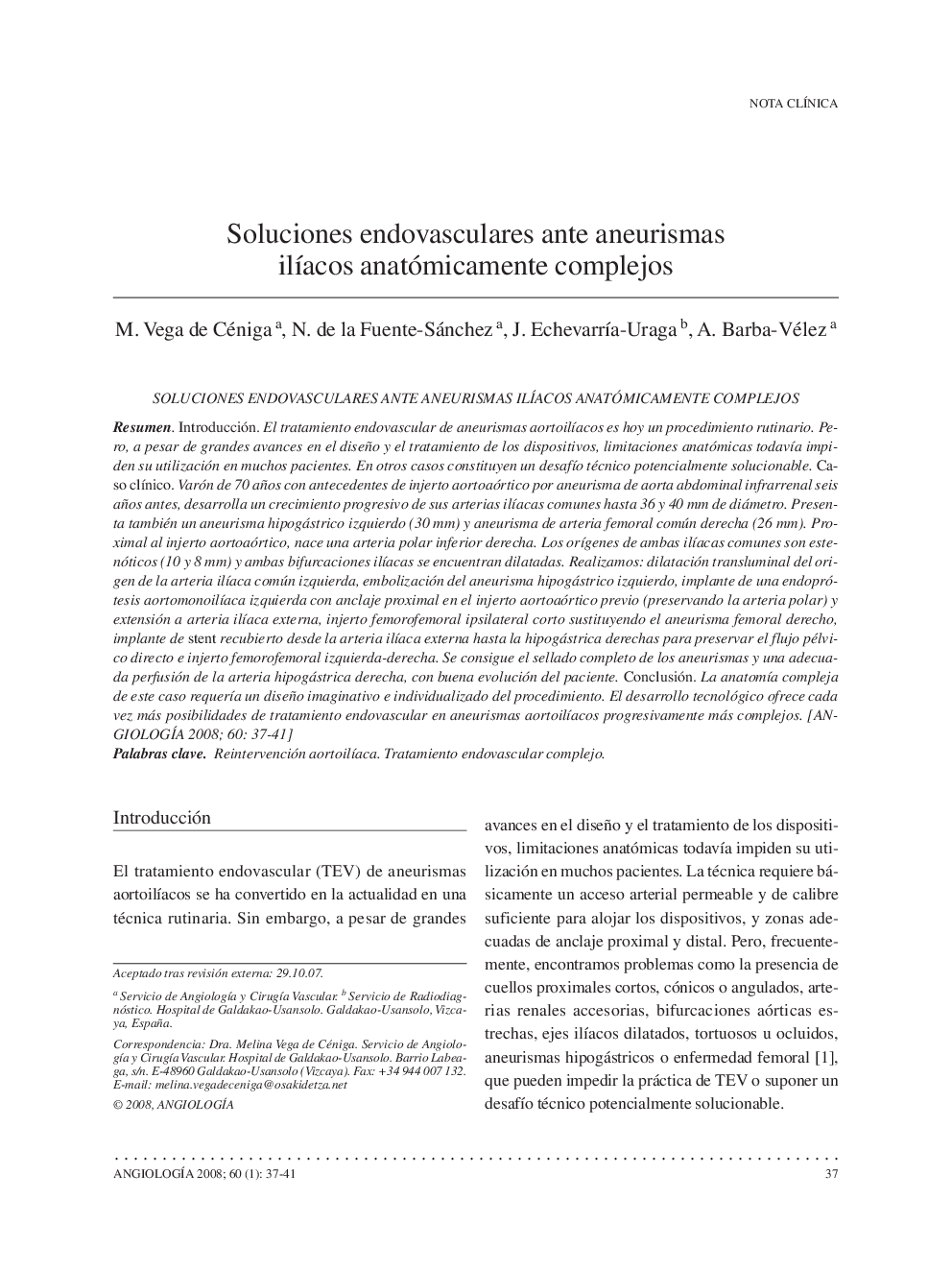| Article ID | Journal | Published Year | Pages | File Type |
|---|---|---|---|---|
| 2868050 | Angiología | 2008 | 5 Pages |
SOLUCIONES ENDOVASCULARES ANTE ANEURISMAS ILÍACOS ANATÓMICAMENTE COMPLEJOSResumen. Introducción. El tratamiento endovascular de aneurismas aortoilíacos es hoy un procedimiento rutinario. Pero, a pesar de grandes avances en el diseño y el tratamiento de los dispositivos, limitaciones anatómicas todavía impiden su utilización en muchos pacientes. En otros casos constituyen un desafío técnico potencialmente solucionable. Caso clínico. Varón de 70 años con antecedentes de injerto aortoaórtico por aneurisma de aorta abdominal infrarrenal seis años antes, desarrolla un crecimiento progresivo de sus arterias ilíacas comunes hasta 36 y 40 mm de diámetro. Presenta también un aneurisma hipogástrico izquierdo (30 mm) y aneurisma de arteria femoral común derecha (26 mm). Proximal al injerto aortoaórtico, nace una arteria polar inferior derecha. Los orígenes de ambas ilíacas comunes son estenóticos (10 y 8 mm) y ambas bifurcaciones ilíacas se encuentran dilatadas. Realizamos: dilatación transluminal del origen de la arteria ilíaca común izquierda, embolización del aneurisma hipogástrico izquierdo, implante de una endoprótesis aortomonoilíaca izquierda con anclaje proximal en el injerto aortoaórtico previo (preservando la arteria polar) y extensión a arteria ilíaca externa, injerto femorofemoral ipsilateral corto sustituyendo el aneurisma femoral derecho, implante de stent recubierto desde la arteria ilíaca externa hasta la hipogástrica derechas para preservar el flujo pélvico directo e injerto femorofemoral izquierda-derecha. Se consigue el sellado completo de los aneurismas y una adecuada perfusión de la arteria hipogástrica derecha, con buena evolución del paciente. Conclusión. La anatomía compleja de este caso requería un diseño imaginativo e individualizado del procedimiento. El desarrollo tecnológico ofrece cada vez más posibilidades de tratamiento endovascular en aneurismas aortoilíacos progresivamente más complejos. [ANGIOLOGÍA 2008; 60: 37-41]
ENDOVASCULAR SOLUTIONS WHEN DEALING WITH ANATOMICALLY COMPLEX ILIAC ANEURYSMSSummary. Introduction. Endovascular treatment of aortoiliac aneurysms is nowadays a rutinary procedure. However, despite great advances in the design and management of the devices, anatomic limitations still preclude its use in many patients. In other cases these limitations become technical challenges which can potentially be solved. Case report. Male, 70-years-old, surgical history of aortoaortic bypass for the treatment of an infrarenal abdominal aortic aneurysm six years previously, develops progressive growth of common iliac arteries up to 36 and 40 mm diameter. The study reveals a left hypogastric aneurysm (30 mm) and a right common femoral aneurysm (26 mm). A right inferior accessory renal artery arises proximal to the aortic graft. The origin of both common iliac arteries is stenotic (10 and 8 mm) and both iliac bifurcations are dilated. We performed: transluminal angioplasty of the origin of the left common iliac artery, embolization of the left hypogastric aneurysm, implant of a left aortoiliac endoprosthesis with proximal seal on the previous aortic graft (preserving the accesory renal artery) and distal extension to the external iliac artery, ipsilateral short femorofemoral bypass substituting the right femoral aneurysm, implant of a stent-graft from the right external iliac artery to the ipsilateral hypogastric artery in order to preserve direct pelvic flow, and left-right femoro-femoral bypass. We achieved complete exclusion of the aneurysms and adequate right hypogastric perfusion, with good recovery of the patient. Conclusion. The complex anatomy of this case required an imaginative and individualized design of the procedure. Technological development offers increasing possibilities for the endovascular treatment of increasingly complex aortoiliac aneurysms. [ANGIOLOGÍA 2008; 60: 37-41]
